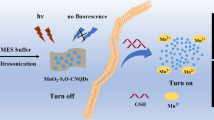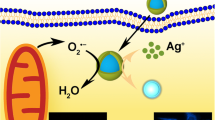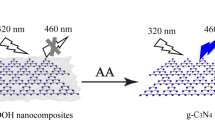Abstract
A ratiometric fluorescence assay for glutathione (GSH) was developed. The novel assay is based on a nanoprobe composed of manganese dioxide nanosheets (MnO2 NS) and dual-emission carbon dots (de-CDs) with intrinsic GSH-response property. After construction of the nanoprobe, two emission peaks of de-CDs were suppressed to varying degrees by MnO2 NS. The suppression was relieved and the two emission peaks recovered proportionally when MnO2 NS was decomposed by GSH, thus realizing the ratiometric assay for micromolar GSH. The intrinsic responsiveness of de-CDs to millimolar GSH broadens the analytical range of the nanoprobe. An appropriate precursor, calcon-carboxylic acid, was screened out to synthesize de-CDs via one-step hydrothermal treatment. The de-CD@MnO2 NS nanoprobe can measure GSH concentrations through the fluorescence intensity ratio between 435 and 516 nm excited at 365 nm. The range of response was from 1 μM to 10 mM and the detection limit reached 0.6 μM (3σ criterion). Benefiting from its good biocompatibility, the proposed nanoprobe has excellent applicability for intracellular GSH imaging.
Graphical abstract

Schematic representation of glutathione (GSH) ratiometric detection. The nanoprobe is prepared from dual-emission carbon dots (de-CDs) and manganese dioxide nanosheets (MnO2 NS). GSH removes quenching effect by decomposing MnO2 NS and induces intrinsic response of de-CDs, which realizes ratiometric detection.







Similar content being viewed by others
References
Ren X, Zou L, Zhang X, Branco V, Wang J, Carvalho C, Holmgren A, Lu J (2017) Redox signaling mediated by thioredoxin and glutathione systems in the central nervous system. Antioxid Redox Sign 27:13
Calabrese G, Morgan B, Riemer J (2017) Mitochondrial glutathione: regulation and functions. Antioxid. Redox Sign 27:15
Sedlak TW, Paul BD, Parker GM, Hester LD, Snowman AM, Taniguchi Y, Kamiya A, Snyder SH, Sawa A (2019) The glutathione cycle shapes synaptic glutamate activity. P Natl Acad Sci U S A 116:2701–2706
Benhar M, Shytaj IL, Stamler JS, Savarino A (2016) Dual targeting of the thioredoxin and glutathione systems in cancer and HIV. J Clin Invest 126:1630–1639
Géhla Z, Bakondi E, Resch MD, Hegedűs C, Kovács K, Lakatos P, Szabó A, Nagy Z, Virág L (2016) Diabetes-induced oxidative stress in the vitreous humor. Redox Biol 9:100–103
Gorrini C, Mak TW (2019) Glutathione metabolism: an Achilles’ heel of ARID1A-deficient tumors. Cancer Cell 35:161–163
Peng HP, Jian ML, Huang ZN, Wang WJ, Deng HH, Wu WH, Liu AL, Xia XH, Chen W (2018) Facile electrochemiluminescence sensing platform based on high-quantum-yield gold nanocluster probe for ultrasensitive glutathione detection. Biosens Bioelectron 105:71–76
Shi W, Song B, Shi W, Qin X, Liu Z, Tan M, Wang L, Song F, Yuan J (2018) Bimodal phosphorescence–magnetic resonance imaging nanoprobes for glutathione based on MnO2 nanosheet–Ru(II) complex nanoarchitecture. ACS Appl Mater Interfaces 10:27681–27691
Zhang Y, Zhang W, Chen K, Yang Q, Hu N, Suo Y, Wang J (2018) Highly sensitive and selective colorimetric detection of glutathione via enhanced Fenton-like reaction of magnetic metal organic framework. Sensor Actuat B – Chem 262:95–101
Hu X, Liu X, Zhang X, Cao H, Huang Y (2019) MnO2 nanowires tuning of photoluminescence of alloy Cu/Ag NCs and thiamine enables a ratiometric fluorescent sensing of glutathione. Sensor Actuat B – Chem 286:476–482
Tang M, Zhu B, Wang Y, Wu H, Chai F, Qu F, Su Z (2019) Nitrogen- and sulfur-doped carbon dots as peroxidase mimetics: colorimetric determination of hydrogen peroxide and glutathione, and fluorimetric determination of lead(II). Microchim Acta 186:604
Tang X, Zeng X, Liu H, Yang Y, Zhou H, Cai H (2019) A nanohybrid composed of MoS2 quantum dots and MnO2 nanosheets with dual-emission and peroxidase mimicking properties for use in ratiometric fluorometric detection and cellular imaging of glutathione. Microchim Acta 186:572
Wu P, Hou X, Xu JJ, Chen HY (2016) Ratiometric fluorescence electrochemiluminescence and photoelectrochemical chemo/biosensing based on semiconductor quantum dots. Nanoscale 8:8427–8442
Huang X, Song J, Yung BC, Huang X, Xiong Y, Chen X (2018) Ratiometric optical nanoprobes enable accurate molecular detection and imaging. Chem Soc Rev 47:2873–2920
Gui R, Jin H, Bu X, Fu Y, Wang Z, Liu Q (2019) Recent advances in dual-emission ratiometric fluorescence probes for chemo/biosensing and bioimaging of biomarkers. Coordin Chem Rev 383:82–103
Ma Z, Wu T, Li P, Liu M, Huang S, Li H, Zhang Y, Yao S (2019) A dual (colorimetric and fluorometric) detection scheme for glutathione and silver (I) based on the oxidase mimicking activity of MnO2 nanosheets. Microchim Acta 186:498
Yin C, Tang Y, Li X, Yang Z, Li J, Li X, Huang W, Fan QA (2018) Single composition architecture-based nanoprobe for ratiometric photoacoustic imaging of glutathione (GSH) in living mice. Small 14:1703400
Qi S, Liu W, Zhang P, Wu J, Zhang H, Ren H, Ge J, Wang P (2018) A colorimetric and probe for highly selective detection of glutathione in the mitochondria of living cells. Sensor Actuat B - Chem 270:459–465
Zheng J, Wu Y, Xing D, Zhang T (2019) Synchronous detection of glutathione/hydrogen peroxide for monitoring redox status in vivo with a ratiometric upconverting nanoprobe. Nano Res 12:931–938
Zhi B, Cui Y, Wang S, Frank BP, Williams DN, Brown RP, Melby ES, Hamers RJ, Rosenzweig Z, Fairbrother DH, Orr G, Haynes CL (2018) Malic acid carbon dots: from super-resolution live-cell imaging to highly efficient separation. ACS Nano 12:5741–5752
Hassan M, Gomes VG, Dehghani A, Ardekani SM (2018) Engineering carbon quantum dots for photomediated theranostics. Nano Res 11:1–41
Du J, Xu N, Fan J, Sun W, Peng X (2019) Carbon dots for in vivo bioimaging and theranostics. Small 15:1805087
Yan F, Sun Z, Zhang H, Sun X, Jiang Y, Bai Z (2019) The fluorescence mechanism of carbon dots, and methods for tuning their emission color: a review. Microchim Acta 186:583
He D, Yang X, HeX MK, He X, Zou Z (2015) A sensitive turn-on fluorescent probe for intracellular imaging of glutathione using single-layer MnO2 nanosheet-quenched fluorescent carbon quantum dots. Chem Commun 51:14764–14767
Wang Y, Jiang K, Zhu J, Zhang L, Lin H (2015) A FRET-based carbon dot–MnO2 nanosheet architecture for glutathione sensing in human whole blood samples. Chem Commun 51:12748–12751
Xu Y, Chen X, Chai R, Xing C, Li H, Yin XB (2016) A magnetic/fluorometric bimodal sensor based on a carbon dots–MnO2 platform for glutathione detection. Nanoscale 8:13414–13421
Cui Y, Liu R, Ye F, Zhao S (2019) Single-excitation dual-emission biomass quantum dots: preparation and application for ratiometric fluorescence imaging of coenzyme A in living cells. Nanoscale 11:9270–9275
Chen L, Park SJ, Wu D, Kim HM, Yoon J (2019) A two-photon fluorescent probe for colorimetric and ratiometric monitoring of mercury in live cells and tissues. Chem Commun 55:1766–1769
Wu S, Min H, Shi W, Cheng P (2019) Multicenter metal–organic framework-based ratiometric fluorescent sensors. Adv Mater 2019:e1805871. https://doi.org/10.1002/adma.201805871
Fan H, Zhao Z, Yan G, Zhang X, Yang C, Meng H, Chen Z, Liu H, Tan W (2015) A smart DNAzyme–MnO2 nanosystem for efficient gene silencing. Angew Chem Int Edit 54:4801–4805
Zhu Z, Zhai Y, Li Z, Zhu P, Mao S, Zhu C, Du D, Belfiore LA, Tang J, Lin Y (2019) Red carbon dots: optical property regulations and applications. Mater Today 30:52–79
Shangguan J, He D, He X, Wang K, Xu F, Liu J, Tang J, Yang X, Huang J (2016) Label-free carbon-dots-based ratiometric fluorescence pH nanoprobes for intracellular pH sensing. Anal Chem 88:7837–7843
Song W, DuanW LY, Ye Z, Chen Y, Chen H, Qi S, Wu J, Liu D, Xiao L, Ren C, Chen X (2017) Ratiometric detection of intracellular lysine and pH with one-pot synthesized dual emissive carbon dots. Anal Chem 89:13626–13633
Dong Y, Shao J, Chen C, Li H, Wang R, Chi Y, Lin X, Chen G (2012) Blue luminescent graphene quantum dots and graphene oxide prepared by tuning the carbonization degree of citric acid. Carbon 50:4738–4743
Chen J, Meng H, Tian Y, Yang R, Du D, Li Z, Qu L, Lin Y (2019) Recent advances in functionalized MnO2 nanosheets for biosensing and biomedicine applications. Nanoscale Horiz 4:321–338
Zhai W, Wang C, Yu P, Wang Y, Mao L (2014) Single-layer MnO2 nanosheets suppressed fluorescence of 7-hydroxycoumarin: mechanistic study and application for sensitive sensing of ascorbic acid in vivo. Anal Chem 86:12206–12213
Deng R, Xie X, Vendrell M, Chang YT, Liu X (2011) Intracellular glutathione detection using MnO2-nanosheet-modified upconversion nanoparticles. J Am Chem Soc 133:20168–20171
Peng C, Xing H, Fan X, Xue Y, Li J, Wang E (2019) Glutathione regulated inner filter effect of MnO2 nanosheets on boron nitride quantum dots for sensitive assay. Anal Chem 91:5762–5767
Cai Q Y, Li J, Ge J, Zhang L, Hu Y L, Li Z H, Qu L B (2015) A rapid fluorescence “switch-on” assay for glutathione detection by using carbon dots–MnO2 nanocomposites. 72: 31-36
Funding
This study was funded by the National Natural Science Foundation of China (Grant No. 21804143 and No. 21576295), the Hunan Provincial Natural Science Foundation of China (2019JJ50759), and the Fundamental Research Funds for the Central Universities of Central South University (2017zzts175 and 2018zzts371).
Author information
Authors and Affiliations
Corresponding authors
Ethics declarations
Conflict of interest
The authors declare that they have no competing interests.
Additional information
Publisher’s note
Springer Nature remains neutral with regard to jurisdictional claims in published maps and institutional affiliations.
Electronic supplementary material
ESM 1
(DOCX 16740 kb)
Rights and permissions
About this article
Cite this article
Deng, Z., Li, X., Liu, H. et al. A nanoprobe for ratiometric imaging of glutathione in living cells based on the use of a nanocomposite prepared from dual-emission carbon dots and manganese dioxide nanosheets. Microchim Acta 187, 537 (2020). https://doi.org/10.1007/s00604-020-04495-1
Received:
Accepted:
Published:
DOI: https://doi.org/10.1007/s00604-020-04495-1




